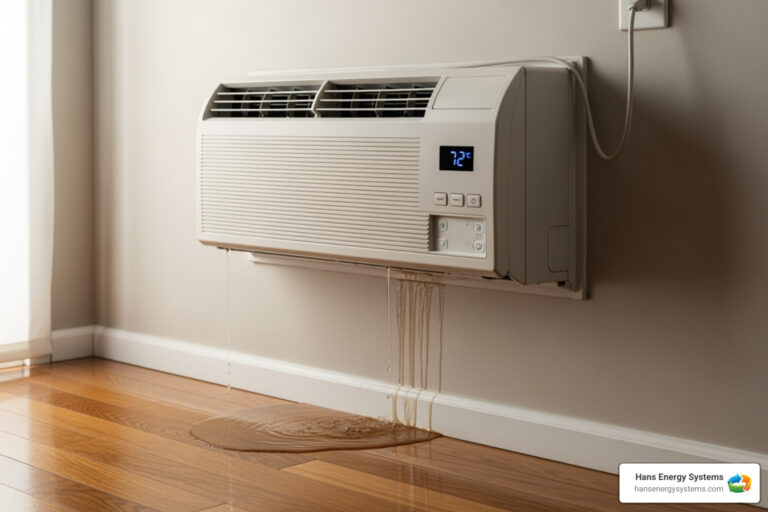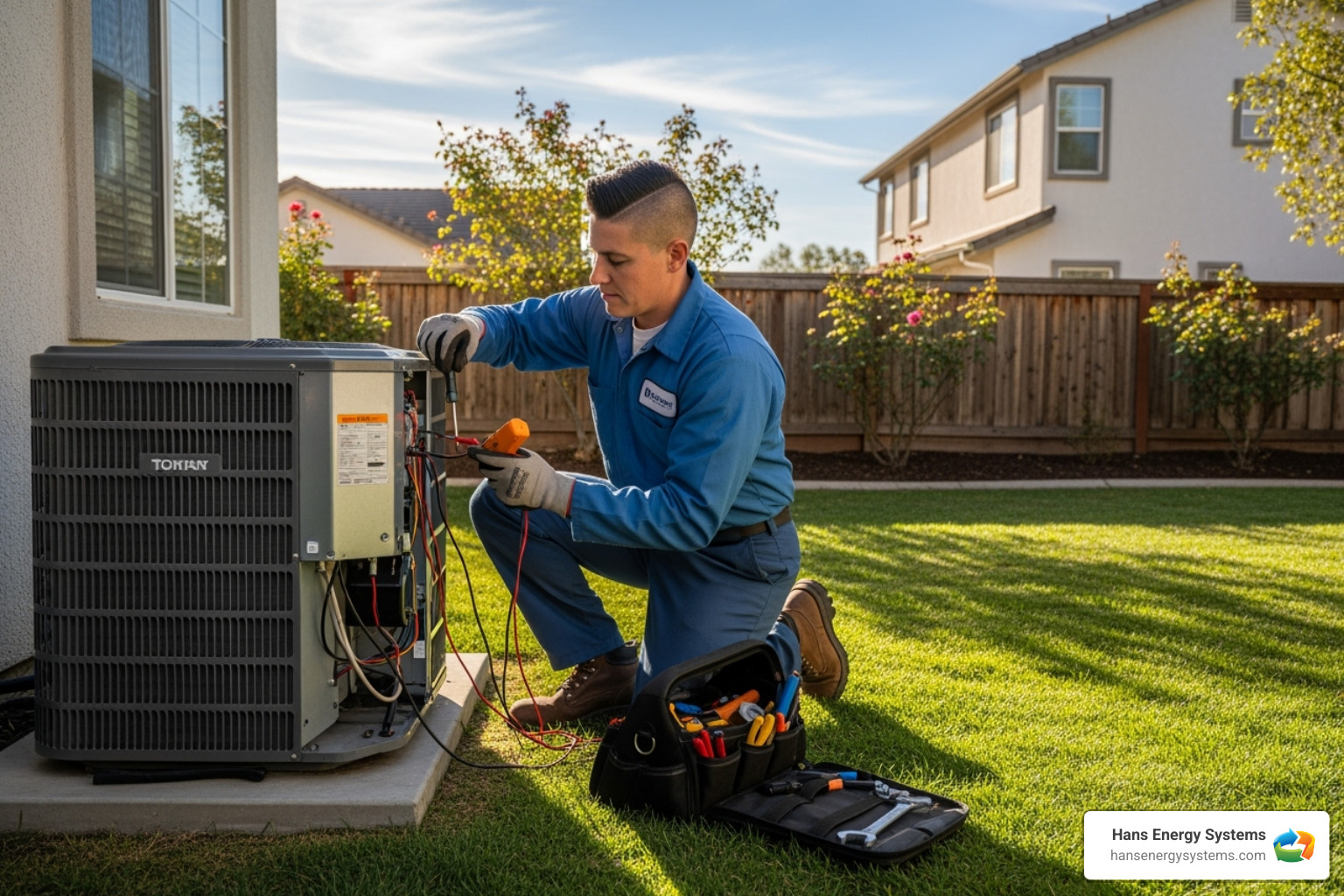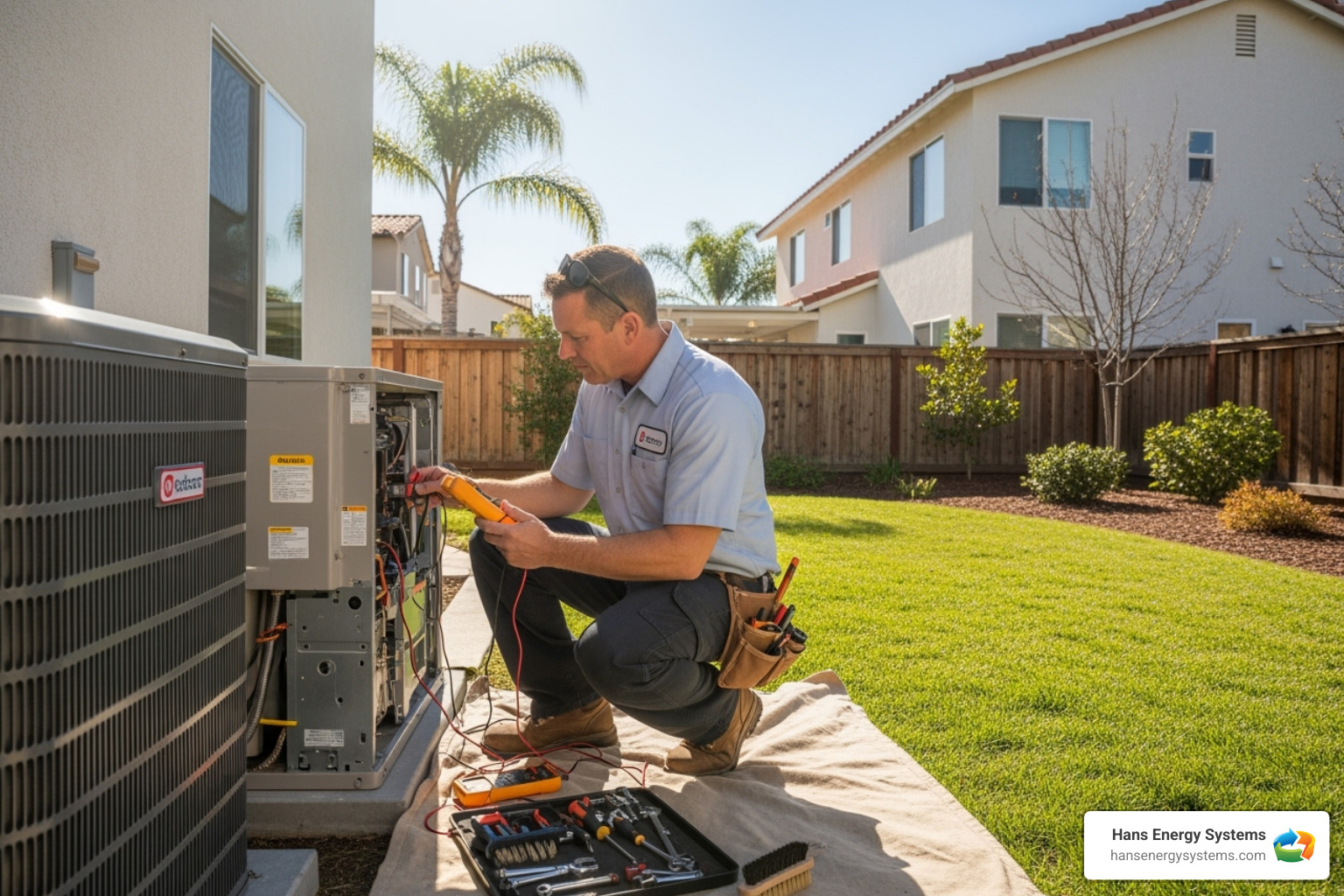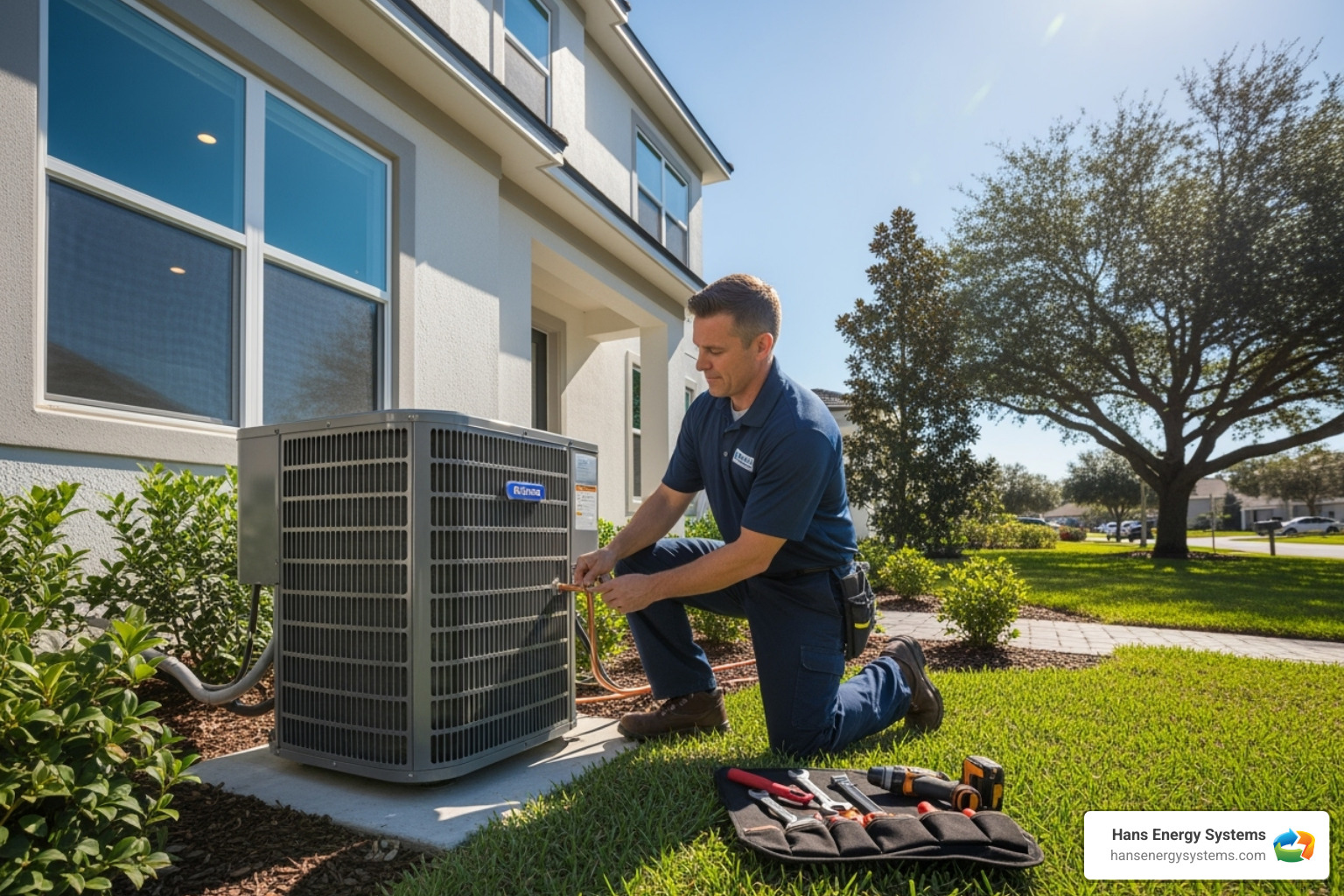Why Your Mini Split is Dripping Water All Over Your Floor
Mini split leaking water is one of the most frustrating problems homeowners face with their ductless systems. You invested in energy-efficient cooling to escape those sky-high utility bills, only to find water stains creeping down your walls or puddles forming on your floors.
Quick Answer: Top 5 Causes of Mini Split Water Leaks
- Clogged condensate drain line – Most common cause (blocked by dirt, debris, algae)
- Dirty air filter – Restricts airflow, causes coils to freeze, then melt and overflow
- Cracked or damaged drain pan – Can’t contain condensation properly
- Improper installation – Unit not level, causing water to pool in wrong areas
- Low refrigerant levels – Causes coils to freeze, creating excess water when ice melts
The good news? Many mini split leaks are simple DIY fixes. A clogged drain line—the most common cause—often just needs a good cleaning, and dirty filters can be washed at home. However, issues like refrigerant leaks or installation problems require professional help to avoid further damage. Since water damage can escalate from a minor annoyance to costly repairs, this guide will help you diagnose the leak and determine if it’s a quick fix or time to call the experts.
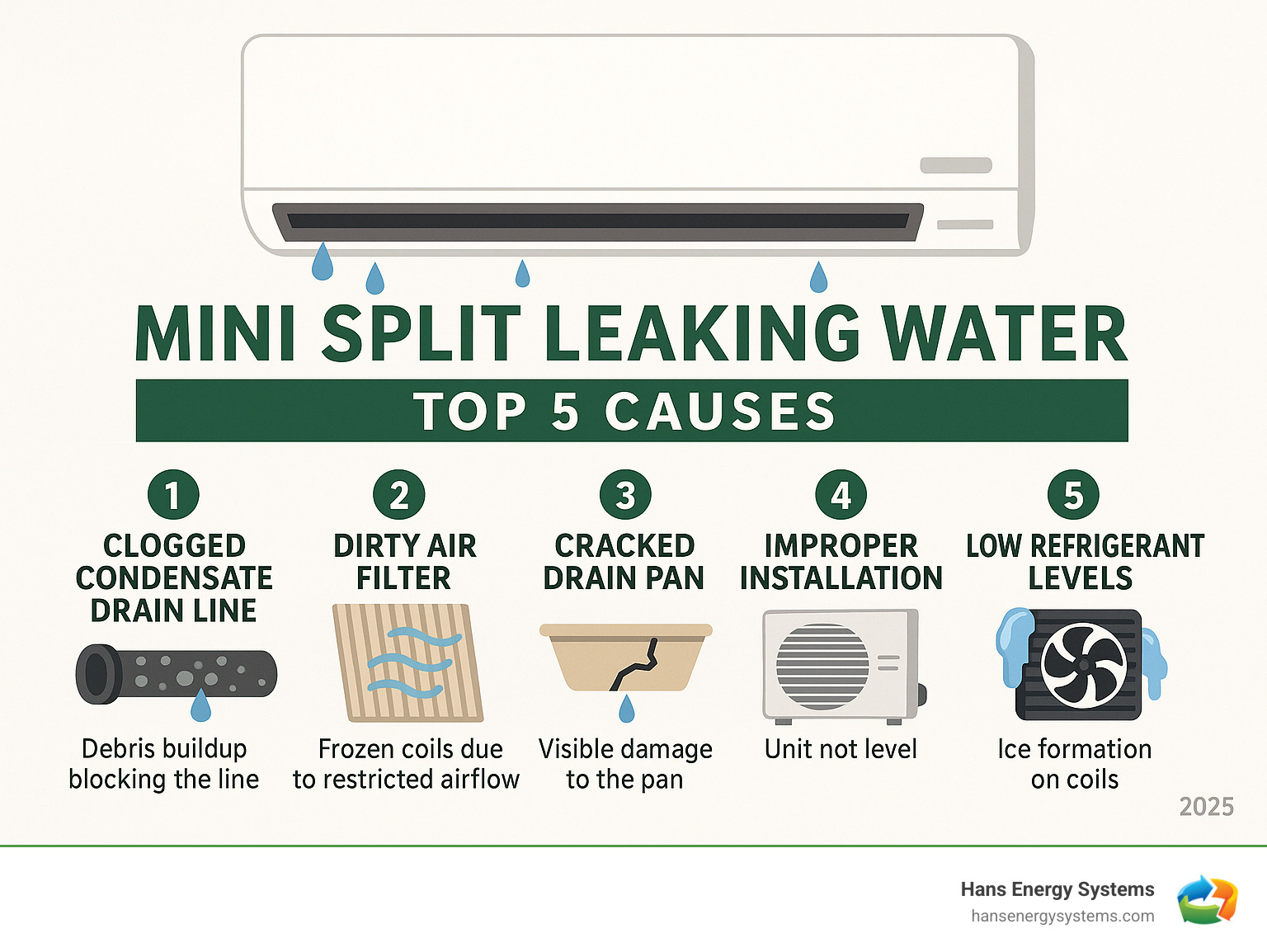
Why Your Mini Split is Leaking Water: Common Causes
Your mini split cools your home by passing warm, humid air over cold evaporator coils, which causes condensation. This normal condensation process is how your system removes humidity. The collected moisture drips into a drain pan and flows outside through a condensate drain line. When this drain system works correctly, you won’t notice it. But when this moisture collection is disrupted, you’ll find your mini split leaking water.
Clogged Condensate Drain Line
Here’s the number one culprit behind most water leaks: a clogged condensate drain line. This narrow pipe might seem innocent enough, but it’s actually a magnet for trouble. Over time, a nasty cocktail of dirt and debris buildup starts accumulating inside the line – we’re talking dust, lint, pet hair, and all sorts of household grime.
The real troublemakers, though, are algae and mold growth. These slimy invaders love the dark, moist environment inside your drain line. They multiply and create a thick, gooey blockage that acts like a cork in a wine bottle.
When this happens, the condensation has nowhere to go. Water backup and overflow becomes inevitable – it’s like trying to drain a bathtub with a completely blocked drain. The water just keeps rising until it spills over the edges of your drain pan and starts dripping from your unit.
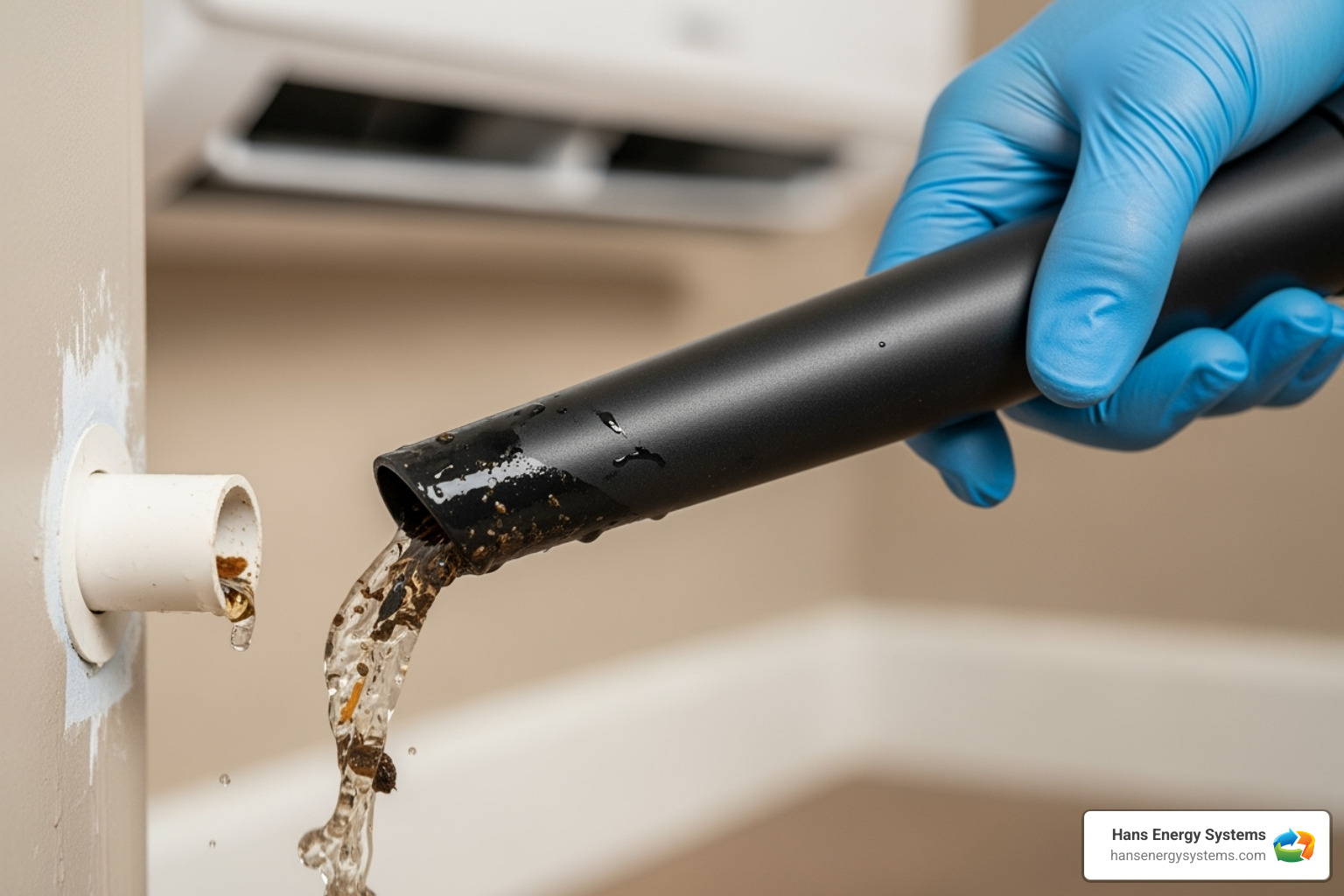
Dirty Air Filter and Frozen Coils
Your air filter might look like a simple piece of mesh, but it’s actually the gatekeeper of your entire system. When it gets clogged with dust and debris, it restricts airflow dramatically. Think of it like trying to breathe through a pillow – not much air gets through.
This creates a domino effect that leads to evaporator coils freezing over. Without enough warm air flowing across them, the coils get so cold they turn into a block of ice. Your mini split essentially becomes a giant popsicle.
The real problem starts when that ice begins to melt. The ice melting and overwhelming the drain pan happens fast – much faster than your drain system was designed to handle. It’s like trying to funnel a fire hose through a drinking straw. The result? Water everywhere.
If you’ve noticed your system freezing up, our guide on Why Your Ductless AC Freezes Up in Summer explains this issue in detail.
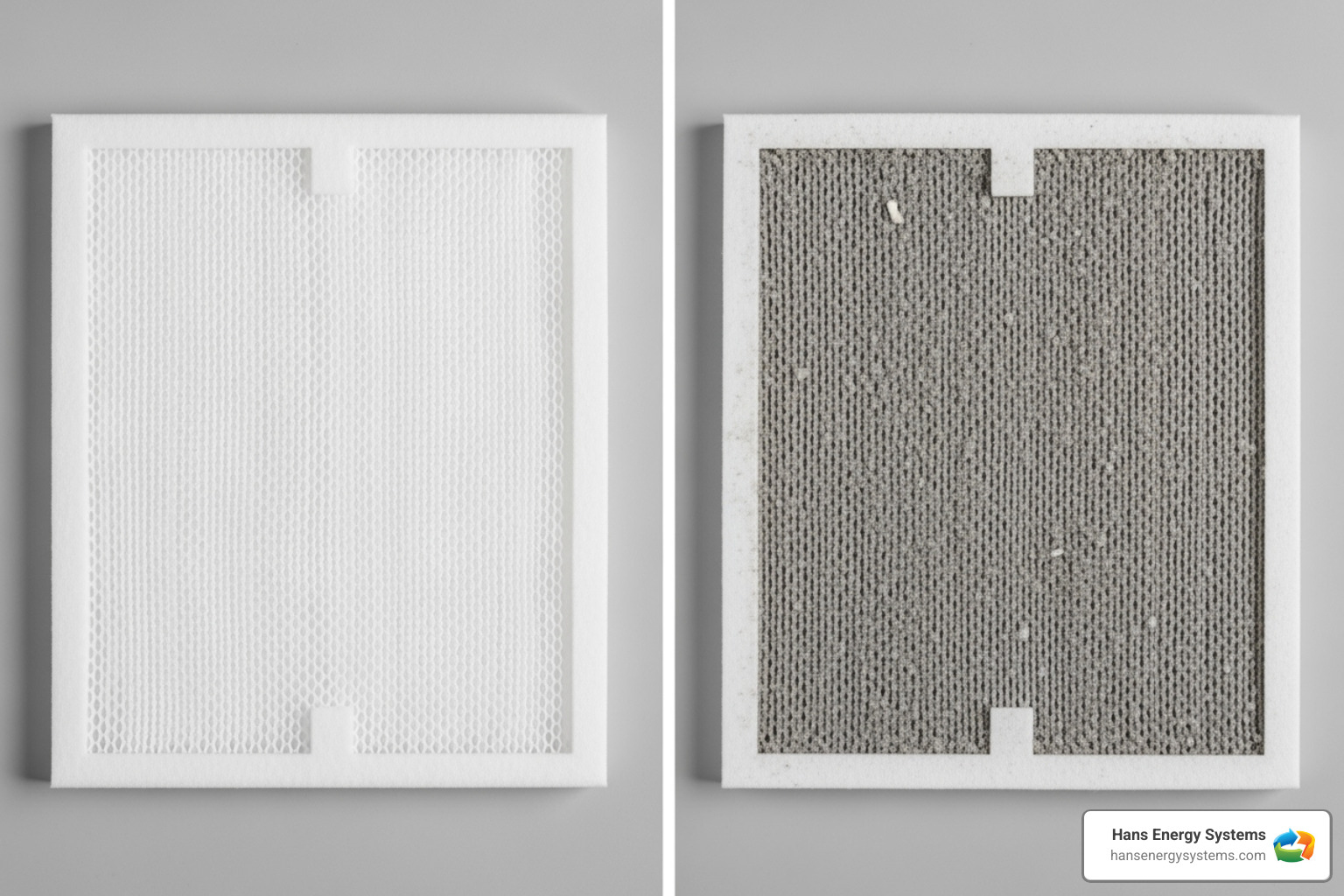
Damaged or Cracked Drain Pan
Your drain pan is the unsung hero of the whole moisture management system – quietly collecting condensation day after day, year after year. But even heroes have their limits.
The role of the drain pan is simple yet crucial: catch every drop of condensation and direct it toward the drain line. But causes of damage can sneak up over time. Age takes its toll on plastic components, making them brittle. Corrosion can eat away at metal pans, especially if cleaning chemicals have splashed on them over the years.
Signs of a cracked pan aren’t always obvious from the outside. You might notice water dripping from areas where it shouldn’t, or find that cleaning the drain line doesn’t solve your leak problem. Sometimes the pan develops hairline cracks that are almost invisible but still allow water to escape.
Improper Installation
Sometimes the problem isn’t wear and tear – it’s that something was wrong from day one. Improper installation can turn even the best mini split into a leaky mess.
The most common issue is when the unit is not level. Mini splits need to be perfectly horizontal (or slightly tilted toward the drain) for water to flow properly. If your unit is tilted the wrong way, condensation will pool in the wrong spot instead of flowing toward the drain.
Incorrect drain line slope is another installation mistake that causes headaches. The drain line needs to slope downward consistently from your indoor unit to the outside. If there are any dips or upward angles, water can get trapped or even flow backward toward your unit.
When installation goes wrong, you’ll see water pooling in the wrong area or overflow from the unit casing instead of neat drainage through the designated line.
Low Refrigerant Levels
Here’s where things get a bit tricky. Low refrigerant levels don’t directly cause water leaks, but they create conditions that lead to massive amounts of water.
Signs of a refrigerant leak include hissing sounds coming from your unit, reduced cooling performance, and ice forming on the coils even when the filter is clean. When refrigerant pressure drops, your evaporator coils get so cold they freeze solid – we’re talking frozen coils from pressure drop.
The important thing to understand is that this isn’t actually a water leak – it’s melting ice from the frozen coils. When all that ice thaws at once, it creates far more water than your drain system can handle, leading to overflow and leaks.
For more detailed information about diagnosing these issues, you can learn more about diagnosing leaks from industry resources.
Step-by-Step DIY Fixes for a Leaky Mini Split
Once you’ve identified the likely culprit, it’s time to fix your mini split leaking water. Safety first: Always turn off the power to your mini split at the circuit breaker before any inspection or maintenance to protect yourself and your system. Once the power is off, gather a few basic tools: a wet/dry vacuum, a screwdriver, clean rags, and mild cleaning supplies. You won’t need specialized equipment for most of these fixes.
How to Fix a Clogged Drain Line in Your Mini-Split
Since a clogged condensate drain line causes the majority of mini split leaking water problems, let’s start with this most common fix. The good news? It’s usually something you can handle yourself with a little patience and the right approach.
Start by locating the drain line exit – this is typically a small PVC pipe or flexible hose that exits your home near the outdoor unit or routes through an exterior wall. You’ll know you’ve found the right one because it should occasionally drip water when your system is running normally.
Set up your wet/dry vacuum with a nozzle that fits snugly over the end of the drain line. Creating a good seal is crucial for effective suction, so don’t hesitate to use duct tape or wrap a rag around the connection if needed. Turn on the vacuum and let it work for several minutes – you’ll likely hear gurgling sounds as water and debris get pulled out of the line.
After vacuuming out the clog, flush the system with a vinegar solution to prevent future blockages. Mix equal parts white vinegar and warm water (about a cup of each), then slowly pour this mixture into the drain pan inside your indoor unit. You may need to remove the front cover to access the pan properly. The vinegar naturally kills mold and algae that love to grow in these moist environments.
How to Address a Dirty Air Filter Causing the Leak
When a dirty air filter is the villain behind your mini split leaking water, you’re in luck – this is one of the easiest problems to solve. A clean filter not only stops leaks but also helps your system run more efficiently.
Open your indoor unit by gently lifting or unclipping the front panel. Most mini splits are designed for easy access, so this shouldn’t require any tools. Carefully slide out the air filters – these thin mesh screens are usually located right behind the front cover.
Take the filters to your kitchen sink or outside to a garden hose. Rinse them thoroughly with lukewarm water, working from the clean side toward the dirty side to avoid pushing debris deeper into the mesh. For particularly grimy filters, a soft brush and mild detergent can help, but avoid harsh chemicals that might damage the filter material.
Here’s the crucial part: let the filters dry completely before reinstalling them. We can’t stress this enough – putting damp filters back creates the perfect breeding ground for mold and mildew. Lay them flat on clean towels or hang them in a well-ventilated area until they’re bone dry.
Once your filters are completely dry, slide them back into place, close the front panel, and restore power to your unit. You should notice improved airflow immediately, and any ice buildup on your coils should start to resolve itself. Regular filter maintenance like this is key to Maximizing Energy Savings with Ductless AC throughout the year.
When to Call a Professional for Your Mini Split Leak
Sometimes the best DIY solution is knowing when to put down your tools and pick up the phone. While we love empowering homeowners to tackle simple fixes, attempting complex repairs on your mini split leaking water can turn a manageable problem into an expensive nightmare. Let’s talk about when it’s time to call in the experts.
You Suspect a Refrigerant Leak
Here’s where things get serious. If your mini split leaking water comes with some unusual warning signs, you might be dealing with a refrigerant leak – and that’s definitely not DIY territory.
Listen for hissing or bubbling noises coming from your unit. These sounds often mean refrigerant is escaping from the lines. Look for oily residue around the unit, especially near the coils or on the floor beneath it. Unlike regular water leaks, refrigerant often has a greasy consistency that’s a dead giveaway.
Poor cooling performance is another red flag. If your unit is struggling to cool your space even after you’ve cleaned the filters and cleared the drain line, low refrigerant could be the culprit. You might also notice ice forming on the coils – when refrigerant levels drop, the pressure changes cause the coils to freeze over.
Refrigerant isn’t just tricky to work with – it can be harmful to your health and the environment if not handled properly. Professional HVAC technicians have specialized equipment to detect leaks safely, recover refrigerant, repair the problem, and recharge your system to the correct levels. It’s simply not worth the risk to tackle this yourself.
The Leak Persists After Cleaning
You’ve been a diligent homeowner. You cleaned those filters until they sparkled, flushed the drain line with vinegar solution, and even gave everything a second cleaning for good measure. But your mini split leaking water problem is still there, mocking your efforts.
When leaks persist after thorough cleaning, you’re dealing with something deeper. A cracked drain pan might be the villain – no amount of cleaning will fix a pan that can’t hold water anymore. A broken condensate pump could be the issue, especially if your drain line needs to push water uphill. These little pumps can fail, causing water to back up and overflow.
Sometimes there’s an internal blockage hiding deep in your system where your wet/dry vacuum can’t reach. Or you might have faulty components like malfunctioning coils or broken fittings that need professional attention. These issues require diagnostic skills and specialized tools that go beyond typical homeowner capabilities.
Persistent leaks can also be a symptom of broader system problems, which ties into other issues like Fixing Uneven Cooling Issues in Ductless AC. A professional can identify these connections and address the root cause.
The Unit Shows Signs of Improper Installation
If your mini split has been giving you grief since day one, or if you’re scratching your head wondering why water is dripping from weird places, improper installation might be your answer.
A visibly tilted unit is often the smoking gun. Your indoor unit should sit level on the wall – if it looks like it’s doing the Leaning Tower of Pisa impression, that’s a problem. Water dripping from the casing instead of flowing properly to the drain area is another telltale sign. When water runs down the back or sides of the unit instead of into the drain pan, something went wrong during installation.
These problems require professional re-leveling and adjustment of the drain line slope. In severe cases, the unit might need complete re-installation. It’s precision work that requires expertise to ensure your system functions as designed. Trying to adjust a mounted unit yourself can be dangerous and might void your warranty.
The good news? Once these installation issues are properly corrected by a professional, your leak problems should disappear for good.
Proactive Maintenance to Prevent Future Leaks
You know what they say about an ounce of prevention being worth a pound of cure? This couldn’t be more true when it comes to your mini split system. Taking a proactive approach to maintenance is your best defense against the frustration of a mini split leaking water all over your floors. Plus, it keeps your system running efficiently, which means lower energy bills and a longer lifespan for your investment.
Think of it this way: would you rather spend a few minutes each month doing some simple maintenance, or deal with water damage to your walls and floors? The choice is pretty clear!
Establish a Regular Cleaning Routine
The good news is that most mini split maintenance is surprisingly straightforward. You don’t need to be an HVAC expert to keep your system in great shape. The key is consistency – making these simple tasks part of your regular home maintenance routine.
Monthly filter cleaning should be at the top of your list, especially during those heavy-use summer and winter months. If you have pets shedding hair, family members who smoke, or live in a particularly dusty area, you might need to clean them every two weeks. This simple step prevents the restricted airflow that leads to frozen coils and subsequent leaks.
Seasonal drain line flushing is another game-changer. At the beginning of cooling season, take a few minutes to flush your condensate drain line with that vinegar and water solution we mentioned earlier, even if you haven’t noticed any problems. This proactive approach stops algae and mold from building up in the first place, rather than waiting until you have a clog to deal with.
Don’t forget about keeping your outdoor unit clear of debris like leaves, grass clippings, and any other outdoor mischief that might accumulate around it. While this doesn’t directly prevent indoor leaks, proper airflow through the outdoor unit supports the overall health of your entire system, including optimal indoor unit function.
The Value of an Annual HVAC Tune-Up
While your monthly cleaning routine is fantastic, it’s not a replacement for professional care. Think of it like brushing your teeth daily but still visiting the dentist for cleanings – both are important for optimal health.
An annual professional tune-up takes maintenance to the next level. During these visits, our technicians perform a comprehensive inspection that goes far beyond what you can do at home. We’ll give your system a professional deep cleaning, tackling not just the filters but also the evaporator coils, blower fan, and drain pan. This removes stubborn grime and buildup that could lead to future clogs or reduce your system’s efficiency.
One of the biggest benefits is early problem detection. We’re trained to spot minor issues before they turn into major headaches – things like hairline cracks in the drain pan or subtle signs of refrigerant leaks that might not be obvious to the untrained eye. We’ll also check your refrigerant levels to ensure they’re optimal, preventing those frozen coil issues that can overwhelm your drain system.
The result? Optimal performance that keeps your system running at peak efficiency, saving you money on energy bills and extending its lifespan. For residents in our area, investing in an HVAC Maintenance Plan Poway CA is a smart way to protect your investment and prevent unexpected leaks from catching you off guard.
Frequently Asked Questions about a Mini Split Leaking Water
When you’re dealing with a mini split leaking water, you probably have a dozen questions racing through your mind. We get it – water dripping from your AC unit can be pretty alarming! Let’s tackle the most common questions we hear from homeowners in situations just like yours.
Can I still use my mini split if it’s leaking?
Here’s the short answer: No, you shouldn’t keep using your mini split if it’s leaking water. We know it’s tempting, especially on a scorching hot day, but running a leaking unit is like ignoring a small kitchen fire – it’s only going to get worse.
The risk of water damage to your walls and floors is real and can get expensive fast. We’ve seen beautiful hardwood floors warped beyond repair and drywall that needed complete replacement because homeowners kept their leaking units running “just until the weekend.”
There’s also the potential for electrical shorts to consider. Water and electricity make terrible roommates, and when they meet, the results can range from fried circuit boards to actual fire hazards. Your mini split has sensitive electronic components that don’t take kindly to unexpected water baths.
Most importantly, continuing to run a leaking unit can worsen the underlying problem. A simple clogged drain that could have been fixed with a wet/dry vacuum might turn into a cracked drain pan or damaged internal components if you ignore it long enough.
Do yourself a favor – turn off the unit at the breaker and figure out what’s causing the leak before you turn it back on.
How can I tell if it’s a water leak or a refrigerant leak?
This is a great question because while both can cause dripping, they’re completely different problems that need different solutions.
Water leaks are just water – clear, odorless, and usually dripping steadily from the indoor unit or around the drain line area. If you can catch some of the liquid and it looks, smells, and feels like regular water, that’s exactly what it is. These leaks typically come from clogged drains, dirty filters causing frozen coils, or cracked drain pans.
Refrigerant leaks often have an oily substance mixed in and tell a different story. You might notice the liquid has a slightly greasy feel or appearance. The big giveaway is usually a hissing sound and a significant drop in cooling power – your mini split will struggle to keep your space comfortable. Sometimes there’s even a faint chemical smell.
Here’s the thing about refrigerant leaks: they cause the coils to freeze up, and when that ice melts, it creates water. So you might see water dripping, but the root cause is the refrigerant issue. If your unit isn’t cooling well and you hear strange noises, call a professional – refrigerant isn’t something you want to mess with on your own.
How often should I clean my mini split’s air filter?
At least once a month during heavy use seasons is our golden rule. That means when you’re running your mini split regularly in summer for cooling or winter for heating, mark your calendar for a monthly filter cleaning session.
But life isn’t always that simple, is it? If you have pets, smokers, or live in a dusty area, you’ll want to check those filters more often – maybe every two weeks. Pet dander, smoke particles, and dust have a way of clogging filters faster than you’d expect.
The good news is that cleaning mini split filters is actually pretty easy. Most homeowners can knock it out in about 10 minutes. Just remember to let them dry completely before putting them back – nobody wants to create a mold situation inside their unit.
Think of filter cleaning as cheap insurance against bigger problems. A clean filter prevents frozen coils, which prevents ice melting and overwhelming your drain system, which prevents your mini split leaking water all over your floor. It’s a pretty good deal for 10 minutes of work each month!
Stop the Drip for Good with Expert Help
When you’re dealing with a mini split leaking water, it’s natural to feel frustrated – especially when you invested in this system for reliable, efficient comfort. The good news is that many of the most common culprits behind these pesky leaks are actually things you can tackle yourself. A clogged condensate drain line responds beautifully to a good cleaning with your wet/dry vacuum, while those dirty air filters causing frozen coils just need a gentle wash and thorough drying.
We’ve walked through these DIY solutions because we believe in empowering homeowners to handle the basics. There’s something satisfying about solving a problem with your own two hands, and these simple maintenance tasks can save you both time and hassle.
But let’s be honest – sometimes the problem runs deeper than what a homeowner should reasonably handle. When you’re looking at a damaged drain pan, improper installation, or the more serious concern of a refrigerant leak, it’s time to call in the professionals. These aren’t just complex fixes; they’re situations where attempting DIY repairs can actually make things worse or even create safety hazards.
Here’s the thing about mini split leaking water issues: preventative maintenance is your best friend. Those monthly filter cleanings and seasonal drain line flushes we talked about? They’re like insurance policies against future headaches. And that annual professional tune-up? It’s your early warning system, catching small problems before they turn into big, messy ones.
For residents in Poway and across San Diego County, Hans Energy Systems provides expert diagnostics and repairs for all your ductless system needs. Our team understands how important your home comfort is, and we’re committed to providing reliable, professional work with the kind of customer service that actually makes you feel heard and valued.
If your mini split is leaking water and you’ve tried the DIY approaches without success, or if you simply want the peace of mind that comes with professional maintenance, we’re here to help. Contact us for all your Ductless AC needs today, and let’s get that drip stopped for good!


